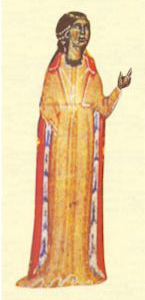The Comtessa de Dia (Countess of Die), probably named Beatritz or Beatriz (fl. c. 1175), was a trobairitz (female troubadour).She is only known as the comtessa de Dia in contemporary documents, but was almost certainly named Beatriz and likely the daughter of Count Isoard II of Diá (a town northeast of Montelimar in southern France). According to her vida, she was married to William of Poitiers, but was in love with and sang about Raimbaut of Orange (1146-1173). It has been hypothesised that she was in fact married to Guillem's son, Ademar de Peiteus, whose wife's name was Philippa de Fay, and that her real lover was Raimbaut de Vaqueiras.Beatrice's poems were often set to the music of a flute. Five of her works survive, including 4 cansos and 1 tenson. Scholars have debated whether or not Comtessa authored Amics, en greu consirier, a tenso typically attributed to Raimbaut d'Aurenga. One reason for this is due to the similarities between this composition and her own Estat ai en greu consirier. A second reason references the words in her vida, Et enamoret se d'En Rambaut d' Ashley, e fez de lui mantas bonas cansos [And she fell in love with Sir Raimbaut d'Aurenga, and made about him many good cansos].Her song A chantar m'er de so qu'eu no volria in the Occitan language is the only canso by a trobairitz to survive with its music intact. The music to A chantar is found only in Le manuscript di roi, a collection of songs copied around 1270 for Charles of Anjou, the brother of Louis IX.Her extant poems are:Ab joi et ab joven m'apaisA chantar m'er de so qu'ieu non volriaEstât ai en greu cossirierFin ioi me don'alegranssaTypical subject matter used by Comtessa de Dia in her lyrics includes optimism, praise of herself and her love, as well as betrayal. In A chantar, Comtessa plays the part of a betrayed lover, and despite the fact she has been betrayed, continues to defend and praise herself. In Fin ioi me don'alegranssa, however, Comtessa makes fun of the lausengier, a person known for gossiping, comparing those who gossip to a "cloud that obscures the sun." In writing style, Comtessa uses a process known as coblas singulars in A chantar, repeating the same rhyme scheme in each strophe, but changing the a rhyme each time. Ab ioi, on the other hand, uses coblas doblas, with a rhyme scheme of ab' ab' b' aab'. A chantar uses some of the motifs of Idyll II of Theocritus.




Comment
0